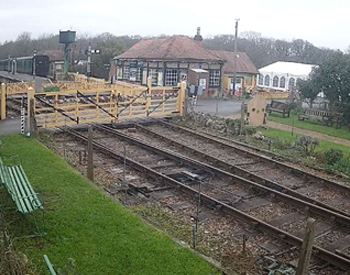How it all began
The first five years
Our beautifully preserved railway creates the perfect backdrop for your special day out. Enjoy a ride on our majestic steam trains and explore the Island’s stunning countryside.
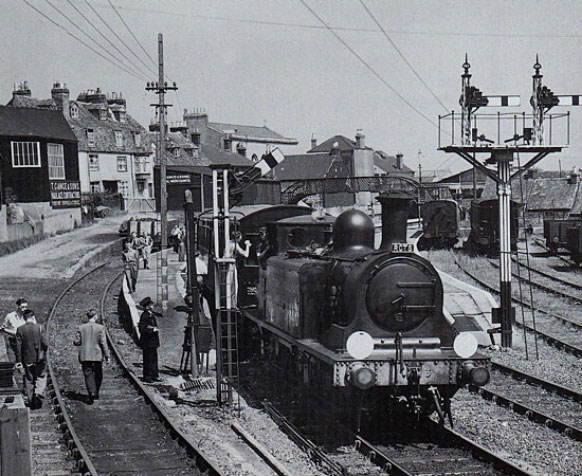
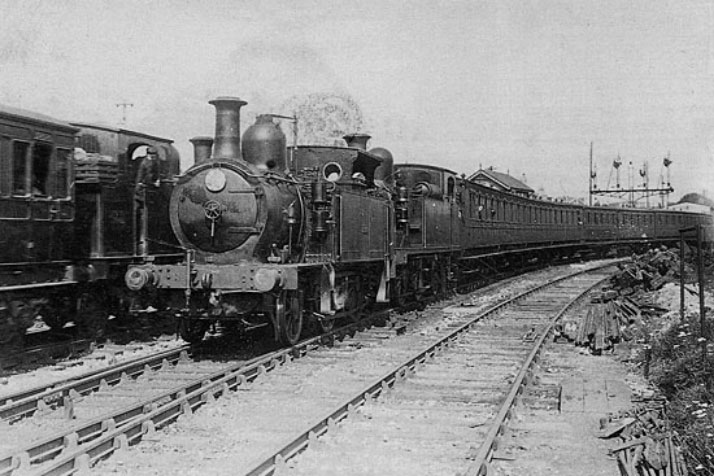
By the mid 20th century, after two World Wars and a lengthy depression, it was not surprising that rural branch lines came under the spotlight and their economic status was in question. The 1950’s saw lines to Bembridge, Freshwater and the very last line opened to Ventnor, all closed. The Island’s steam hauled railways were becoming a sad reflection of their former glory but still retaining a fascination for historians and enthusiasts as the Island’s isolation had seen the retention of antiquated locomotives and carriages, most of which had arrived as hand-me-downs from the mainland.
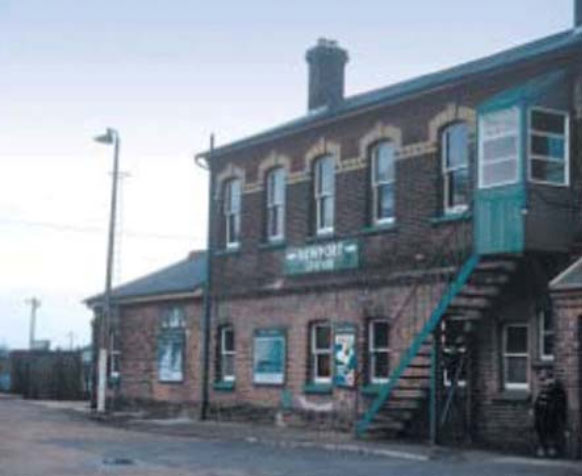
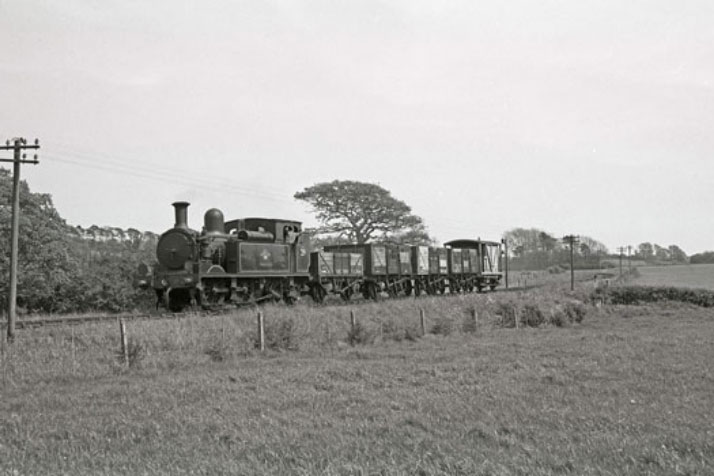
In 1965 the remaining lines from Cowes and Ventnor to Ryde were under threat of closure and there was interest from various parties in trying to preserve some of the Island’s, by now, unique hardware. Similarly an eleventh hour rearguard action to prevent closure was mounted and a scheme to operate the Cowes line with private investment was launched by an organisation known as Vectrail.
The story of the Isle of Wight Steam Railway begins with one of those interested parties, Ron Strutt a mid teens chap who had a few years earlier tried to purchase one of the old Island engines from British Rail … but had failed. Ron and friend Iain Whitlam called a meeting in south London during late ’65 to gather interest from like minded people in possibly preserving something of the old Island railways. Iain coined the name Wight Locomotive Society and they agreed to try and secure at least one ex London & South Western Railway O2 class engine and possibly a carriage or few.
Whilst the more optimistic felt it may be possible to lease back from British Railways part of the shortly-to-be-closed railway, others were more realistic and suggested static preservation may be possible; but if the Vectrail scheme came to fruition some limited form of operation could happen. Sights were set at a realistic level but all around them other individuals and groups were telling the World what they were going to preserve from the impending graveyard of historic stock.
The pressure groups and politics had some effect on the railways of Wight; the line from Cowes to Ryde remained open until February 1966 and only part of the Ventnor route, that from Shanklin to Ventnor itself closed in April the same year.
A modernisation programme was to see the end of the old steam trains and the line from Ryde Pier to Shanklin was electrified to accommodate ex London Transport tube trains. The last steam train operated the delayed 10.12pm service from Shanklin to Ryde St John’s Road on 31st December 1966.
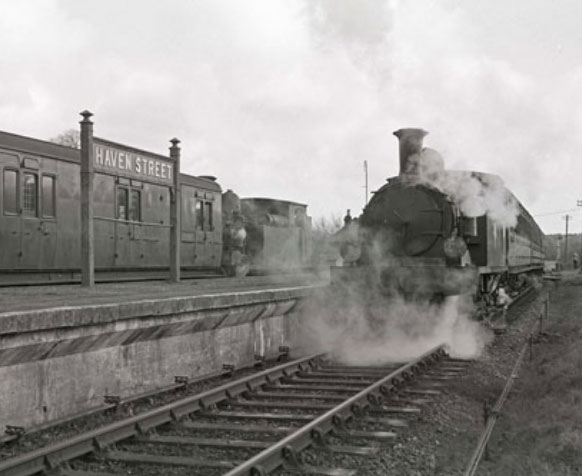
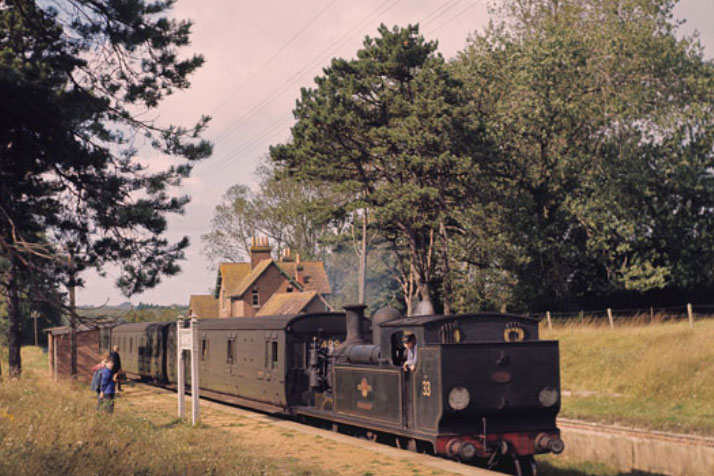
The Wight Locomotive Society had mustered its troops. Armed with appeal leaflets and collecting tins their presence at the last week of steam trains could not be missed. What many did not know at that time was that a few weeks earlier a budding wildlife artist David Shepherd had a conversation in the offices of publisher and lifelong railway enthusiast Ian Allan at which Mr Shepherd expressed an interest in helping one of the growing number of groups throughout the U.K. appealing for funds to save steam engines. The reply he received was, to quote, “David, if you have £500 to spend, why don’t you buy an 02 class tank engine?” A visit to the Island with W.L.S. members in November 1966 sealed the deal and the fighting fund was much nearer to raising the £900 needed to buy a locomotive.
The Isle of Wight Steam Railway probably owes its existence to this chance conversation as, with one exception, all of the other attempts to secure engines and rolling stock from the Island sank without trace. The exception was an individual who secured one coach on behalf of Canadian interests but even this lost its way and eventually came into W.L.S. ownership.
So, after the game the final score: One 02 class locomotive called CALBOURNE, two ex South Eastern & Chatham carriages and three ex London Brighton & South Coast vehicles. Over the next couple of years a few ancient goods wagons and a crane also joined the, by now, unique collection.
But what of operations? The locomotive was located at Ryde St John’s Road as it had been used during 1967 to assist with engineering work on the newly electrified Shanklin line and was effectively stranded when the connection with the old Cowes track was severed. The coaches were at Newport station together with the remaining redundant engines, wagons and carriages, all of which were in the sights of the scrap team who relentlessly worked their way through the lines leaving little but soggy asbestos and globules of molten glass which had fallen from burning carriages.
The prospects of the Vectrail group (remember them?) waxed and waned with the moon, its greatest hope was the Sadler Rail Car and its sponsor who may be persuaded to fund the revival of the Cowes-Ryde railway. But like all such schemes, whilst the local authorities and British Railways were patient, in the end it’s the cash that counts! The W.L.S. on the other hand had seen the writing on the wall and after a little internal wrangling agreed to prepare a case to secure a short piece of line on which to store and possibly operate its collection, its exact length dependant on available funds, In 1969 the engine was moved by road from Ryde to join its train at Newport and work started in earnest to make it operational… it had to be done as the Society hoped to make its new base at Haven Street, some miles away by rail.
Autumn 1970 and Vectrail was laid to rest and CALBOURNE was in steam; local negotiations allowed limited operation around the Newport station site to test and hone our operating skills. These negotiations had taken some time to fructify and certain clandestine and nocturnal movements of stock may have taken place … perhaps the root of some ‘ghost train’ stories which later came to our ears!
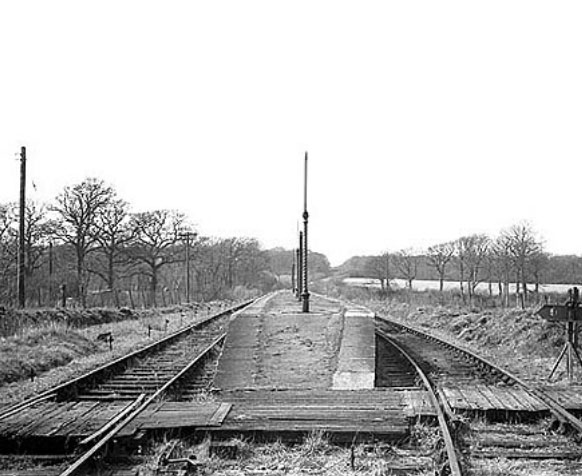
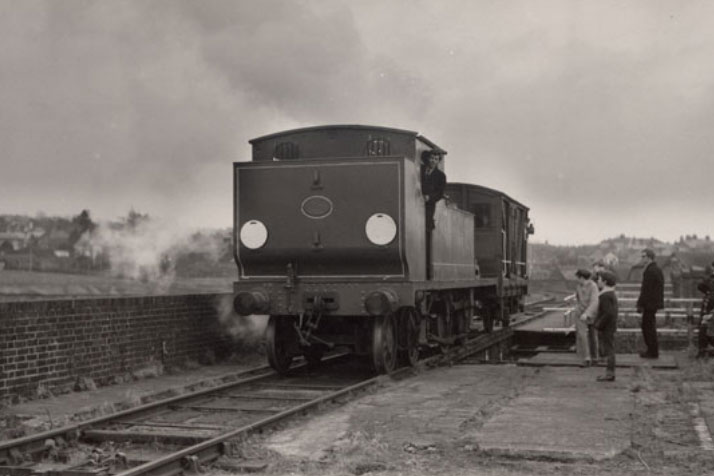
Negotiations also took place with both the local Council and British Railways regarding the purchase of a chunk of line and various other equipment such as water tanks, trackwork and buffer stops, all of which were going to be needed if a railway was to be run. The W.L.S. raised funds like never before, the continued existence of the historic stock depended on it and sufficient was raised to pay the deposit on 1 and 5/8 mile of line from Wootton (with road access) to Haven Street also with road access and both on a bus route! There was little of engineering interest on the section and with a little t.l.c. it was hoped a train would run in a short while.
All this was at the planning stage when on Monday 18th January 1971 notice to quit Newport station arrived – it all had to be gone by 25th!
Although not unexpected, and some preliminary work on the track to Haven Street had been carried out, it came as a shock. A meeting was called at a pub near the Fishbourne car ferry terminal that night, mainlanders and locals formulating a plan of action … After closing time and perhaps with the help of a little alcohol things didn’t look so bad. Tuesday saw frantic action, teams started to load ‘stuff’ onto wagons and vans (preservationists gather lots of ‘stuff’), and others headed off for Cowes on the remains of an old Ryde Pier Tram to gather steel rail keys – these to replace the wooden ones which had kept home fires burning between Newport and Havenstreet for the past few years. Posters were printed and nailed to trees and posts all along the line warning trespassers to be wary of train movements over the next few days. It came as quite a shock to many a dog and owner when the tram, laden with track materials and water tanks bore down on them through the grass covered tracks at 30 miles an hour, the liberal use of the hand operated klaxon was a perverse joy of the driver on these trips.
There were two main obstacles on the line to Havenstreet. The first just yards from base camp, was the draw bridge which carried the lines over the River Medina. It had not been opened for years and we had avoided crossing it during operations around the station. It was inspected by our engineers and found to be intact. Theft of bearings was feared but unfounded. A rather fatalistic attitude prevailed amongst our youthful number. If it all falls in we walk away and deny everything, remembering to wear running shoes on the day.
The second obstruction was more manageable. There had been an ongoing clay problem at Wootton for years and it was sited just a few feet short of the line we were about to purchase. This slippage and heave had to be crossed to give rail access to our line. A small team of Boy Scouts, their Leader and one other chappy went to look at the job on Thursday. By Friday some of the clay slip was cleared and the track, which had a distinct kink in it, packed and ballasted to provide a solid base. The team went away very pleased they had done their best but it rained – Oh how it rained – and by Saturday, just 24 hours before it needed to carry trains, the lines lay suspended in fresh air surrounded by a sea of mud. The tram arrived a little before midday Saturday laden with timber packing, in fact the skeletal remains of numerous old wagons that had previously been broken up at Newport, plus a few hundred weights of ballast scooped from the four-foot on the way. Frantic was the action and a sort of raft was created under the track but there was no means of load testing so the team leader undertook to standby when the first trains crossed, although exactly what action he could have taken if the train toppled I don’t know but from his location he was certainly going to go down with the sinking ship!
Sunday 24th January 1971, a date that will go down in history, well in the history of the Isle of Wight Steam Railway at least … it was our first day or was it our last? At Newport it dawned bright, pumps were lifting water from the track drains into locomotive and other water barrels, and last minute preparations to run four steam hauled trains to Havenstreet were well under way. The water situation had been caused by the impending sale of the railway land to the local authorities. As part of this process the water supply, which the W.L.S. had been using for four years without charge, was cut off and the only alternative was to use the track drains as a reservoir by blocking the outlets. You will recall it rained on Friday night and by Saturday most of Newport station was under water up to two feet in places.
The locomotive crew was at first under the supervision of former driver Tony Tiltman. His ex boss Ivor Davies from Ryde Works also gave advice along with WLS member John Wenyon from Eastleigh Works. Later model maker Don Young joined for a trip but as the day wore on Bob Huxtable and Tom Jackman were left to their own devices with a guest appearance of this author on the footplate of the very last trip. This resulted in a stop at Whippingham to ‘blow up’ which all goes to prove I’m no better with a shovel than a pen!
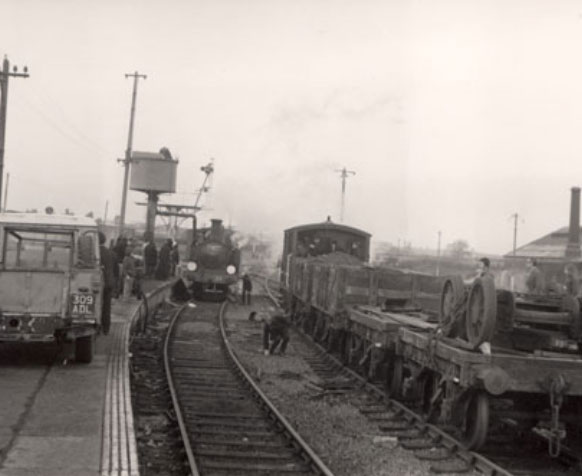

The WLS had a commitment to its members to tell them when the move was to take place. We were in the middle of a postal strike and it was years before texts and e-mail. Press Officer Richard Newman and friends did their very best to contact as many as possible and he was able to issue them with tickets for the very last train from Newport. George Wheeler was the person who had undertaken training of guards and shunters over the previous months and he set out the timetable and method of working for the ‘move’. It was planned to run two passenger trains at 10.40 and 12.15 of three carriages each, then two goods trains (we had by now acquired a number of additional goods vehicles from the defunct Vectral), and all this was interlaced around ‘Rail Motor Car’ (the tram) and light engine workings. Somewhere in the middle of all this was a stop at the one time Royal Station of Whippingham where a letter was set down for onward conveyance to Her Majesty The Queen. She must have remembered it, as she came to visit us at Havenstrett 33 years later!
The schedule was all very optimistic but how often does moving home go exactly to plan? At about 8.30pm the last Rail Motor left Newport. The station deserted and silent, had seen its last train. The tram crew were fighting a battle of which few knew in the euphoria of the day, they had run out of gaffer tape to stick a leaking fuel pipe and one of their number was holding the connection together, the transmission had given up the ghost hours ago and was held together with a succession of bent 6″ nails whose lifespan depended on the use of the right foot of the driver! They had been booked into Haven Street at 5pm but it was gone ten when the crew arrived in the local pub to a great cheer from the crowd and a rendition of The Runaway Train on the piano by the landlord.
We had arrived, day one at the Isle of Wight Steam Railway was over and we all slept well for the first time in a week.
The scrap merchants really did start work on the following week and progress was rapid. We managed a couple of trips with the tram from Haven Street to Smallbrook to ‘recover’ sundry items and another team were at Newport marking up the various pointwork which we had purchased. Local deals also included an amount of signalling wire and equipment which we were lacking. To be honest, at Haven Street we were lacking most things. All the stock was crammed into the up and down loops as there were no sidings, the building was boarded up, no water, no electric, but we did have an old concrete p/way hut complete with stove; what a way to run a railway!
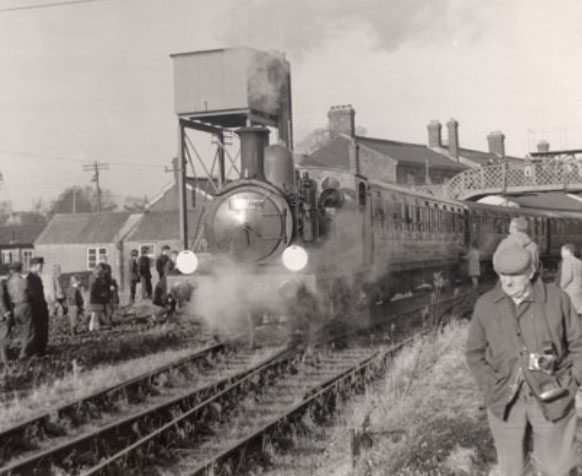
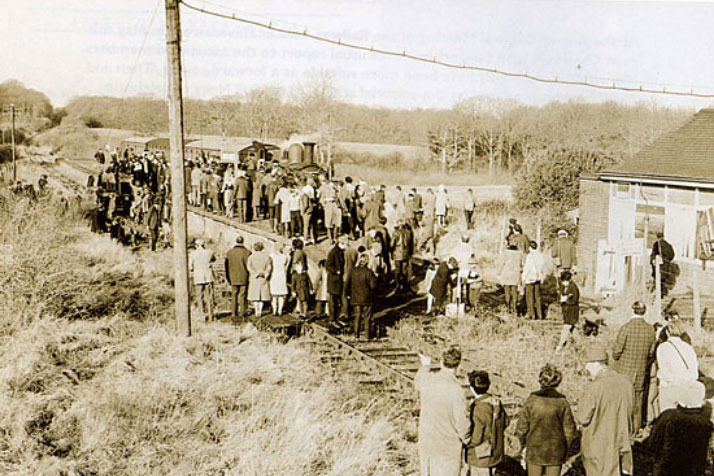
The intention was to open for the public at Easter. That was less than ten weeks away if I recall. Boards came off the building and the water turned on; there was no electric to turn on so oil lamps were the order of the day. A pump was mounted on a flat truck and was shunted to an overbridge where river water was pumped directly into the locomotive. A form of pull/push working was devised with the brake van leading towards Wootton. CALBOURNE located on the down hill end was in communication with the guard through a Heath-Robinson bell system, although I am not certain if this was in place on that very first day.
Sadly the spring was not kind, that rain returned and parts of the line became rivers. This delayed even the most rudimentary track work planned so that by Easter it was decided only to operate as far as Woodhouse Crossing, a little short of half distance.
But it happened! On Easter Monday CALBOURNE and its train of three ex-LB&SCR carriages puffed their merry way to Woodhouse and back and carried around 1000 passengers in the process.
In recent months there has been much head scratching about the timetable for those first days; search as we may there is no trace. Nor were Guard’s journals used for some months, but a recent conversation with George Wheeler, our one time Operations guy brought it all back… “Well it was very much a case of when Jacko (Tom Jackman, driver) said he’s got steam, we go!” and so we did!
Terry Hastings – 25-05-10
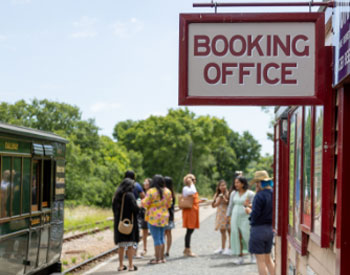
OPENING DAYS + TIMES
Our Havenstreet booking office and station open at 9.30am every day when trains are running…
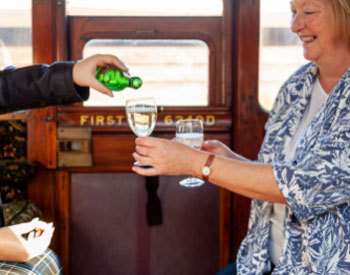
EXCLUSIVE EXPERIENCES
Go on treat yourself, whether you want to be at the coal face with the immersive Footplate Experience or you want absolute luxury…

TRAIN RIDES
The Isle of Wight Steam Railway will take you back in time to the heyday of steam, our traditional steam trains…
